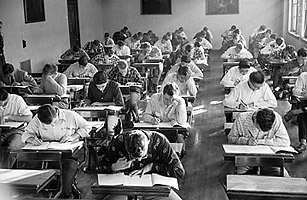
Throughout the U.S., students are getting out their No. 2 pencils, ready to endure a stress-packed four hours of bubbling in answers in the Dec. 12 administration of the ACT. Some 1.5 million students are expected to take the test this school year. Standardized tests have been a scourge of student life in America for more than 50 years, but it’s fair to say they’re more pressure-packed and ubiquitous than ever before. The ACT and its counterpart, the SAT, have become one of the largest determining factors in the college-admissions process, particularly for lite schools. At least this year’s applicants should be familiar with the format by now: students in the U.S. are taking more standardized tests than ever before, and at ages long before college beckons.
The earliest record of standardized testing comes from China, where hopefuls for government jobs had to fill out examinations testing their knowledge of Confucian philosophy and poetry. In the Western world, examiners usually favored giving essays, a tradition stemming from the ancient Greeks’ affinity for the Socratic method. But as the Industrial Revolution took school-age kids out of the farms and factories and put them behind desks, standardized examinations emerged as an easy way to test large numbers of students quickly.
In 1905 French psychologist Alfred Binet began developing a standardized test of intelligence, work that would eventually be incorporated into a version of the modern IQ test, dubbed the Stanford-Binet Intelligence Test. By World War I, standardized testing was standard practice: aptitude quizzes called Army Mental Tests were conducted to assign U.S. servicemen jobs during the war effort. But grading was at first done manually, an arduous task that undermined standardized testing’s goal of speedy mass assessment. It would take until 1936 to develop the first automatic test scanner, a rudimentary computer called the IBM 805. It used electrical current to detect marks made by special pencils on tests, giving rise to the now ubiquitous bubbling-in of answers.
The SAT and the ACT are by far the most famous standardized tests today. The SAT came first, founded in 1926 as the Scholastic Aptitude Test by the College Board, a nonprofit group of universities and other educational organizations. The original test lasted 90 minutes and consisted of 315 questions testing knowledge of vocabulary and basic math and even including an early iteration of the famed fill-in-the-blank analogies . The test grew and by 1930 assumed its now familiar form, with separate verbal and math tests. By the end of World War II, the test was accepted by enough universities that it became a standard rite of passage for college-bound high school seniors. It remained largely unchanged until 2005, when the analogies were done away with and a writing section was added.
In 1959 an education professor at the University of Iowa named Everett Franklin Lindquist developed the ACT as a competitor to the SAT. Originally an acronym for American College Testing, the exam included a section that guided students toward a course of study by asking questions about their interests. In addition to math, reading and English skills, the ACT assesses students on their knowledge of scientific facts and principles; the test is scored on a scale of 0 to 36. Both the ACT and the SAT have found a niche: the ACT is more commonly accepted in the Midwest and South, while schools on the coasts show a preference for the SAT. Students show a propensity for one test or the other: the SAT is geared toward testing logic, while the ACT is considered more a test of accumulated knowledge. One thing the tests have in common: their names no longer have any official meaning. Any pretense of the letters being acronyms was dropped decades ago. They’re now simply the ACT and SAT.
In the 21st century, however, the SAT and the ACT are just part of a gauntlet of tests students may face before reaching college. The College Board also offers SAT II tests, designed for individual subjects ranging from biology to geography. The marathon four-hour Advanced Placement examinations — which some universities accept for students who want to opt out of introductory college-level classes — remain popular: nearly 350,000 took the U.S. history AP test last year, the most popular subject test offered. There’s also the PSAT, taken in the junior year as preparation for the full-blown SAT and as an assessment for the coveted National Merit Scholarships. And we’ve still only covered high school — one of the main criticisms of President George W. Bush’s 2001 No Child Left Behind education reform was its expansion of state-mandated standardized testing as means of assessing school performance. Now most students are tested each year of grade school as well. That means that by the time they graduate to college — where the essay, the experiment and the case study still rule — the reprieve from bubble-filling and time limits is a welcome one indeed.
See pictures of young Americans.